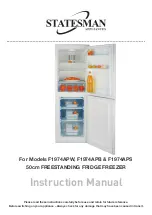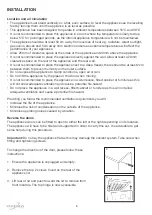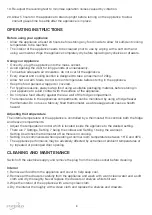
11
TROUBLESHOOTING
If you are having problems with your appliance, please use our troubleshooting guide below. If you
are unable to resolve the issue using this guide please ring our Customer Service Department on
0844 848 5861. Please have the model code and purchase information available.
Appliance does
not work
Temperature control dial is
set at number “0”.
Mains plug is not plugged in
or is loose
Insert mains plug.
Fuse has blown or is defective
Check fuse, replace if necessary.
Socket is defective
Mains malfunctions are to be
corrected by an electrician.
Temperature is not properly
adjusted.
Door was open for an extended
period.
Open the door only as long as
necessary.
A large quantity of warm food
was placed in the appliance
within the last 24 hours.
Turn the temperature regulation
to a colder setting temporarily.
The appliance is near a heat
source.
Please look in the ‘Installation’
section.
Temperature is set too cold.
Turn the temperature regulation knob
to a warmer setting temporarily.
Appliance is not level.
Re-adjust the feet.
The appliance is touching the
wall or other objects.
Move the appliance slightly.
Water drain hole is blocked.
See the ‘Cleaning and Maintenance’
section.
It’s normal. Heat exchange parts
are in the sides.
Use gloves to touch sides.
A component, e.g. a pipe, on the rear
of the appliance is touching another
part of the appliance or the wall.
If necessary, carefully bend the
component out of the way.
Set the dial to another number to
switch on the appliance.
Fault
Possible cause
Solution
The food is too
warm.
Please look in the initial
‘Temperature Setting’ section.
Appliance cools
too much
Unusual noises
Water on the floor
Side panels are hot.
DISPOSAL
The European Directive 2012/19/EU on Waste Electrical and Electronic Equipment
(WEEE), requires that old household electrical appliances must not be disposed of in
normal unsorted municipal waste.
Old appliances must be collected separately in order to optimise the recovery and
recycling of the materials they contain and reduce the impact on human health and the
environment.
The crossed out “wheeled bin” symbol on the product reminds you of your obligation,
that when you dispose of the appliance it must be separately collected. Consumers
should contact their local authority or retailer for information concerning the correct
disposal of their old appliance.






























